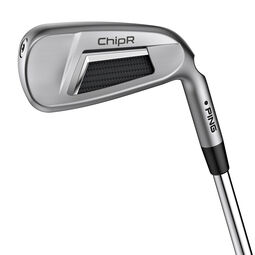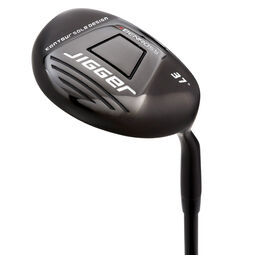We stock a range of golf chippers for brands including Benross and Fazer as well as a variety of left handed golf clubs and junior golf clubs.
Golf Chippers
Gender
Brand
Hand
Loft
Flex
New In
Price range
Gender
Brand
Hand
Loft
Flex
New In
Price range
Chippers
American Golf gives succour to golfers who struggle severely with their chipping in and around the greens. If you struggle with consistency, confidence and even the dreadful chipping yips, our impressive lineup exists to guarantee tremendously improving your pitching and chipping. The chipper was invented to remove all possible problems that a wedge can have when attempting to bump and run the ball destined for the pin. The chipper is designed as a combination of both a putter, and wedge in order to easily allow a player to perform a simple putting stroke action and with the lofted putting style/wedge head, which is enough to cleanly lift the ball off the turf and fire it towards the pin in a bump and run motion. These clubs are available from brands such as Fazer, Benross and Rife , and are available in both male and female options.
Custom Fitting
While none of our chippers feature the option of being custom ordered, we still highly recommend taking full advantage of our much-favoured custom-fitting process to ensure you pick the perfect chipper for you. Our highly rated service is available both online and in-store to provide you with the best possible service.
Concept
Chippers are a highly useful invention as they provide an easier alternative for chipping and pitching the ball towards the flag. Each chipper features a merge of both a wedge and a putter design. This includes having a steel shaft and with a mallet putter style head with a face set at around 37 degrees of loft. Some golfers are firstly taught to play a chip and run shot with a 7 iron because this provides the perfect flight for the chip or pitch. The 37 degrees chipper loft is therefore of similar loft to the average 7 iron. The reasoning for this is so a golfer can simply perform a second nature putting stroke and let the lofted, cavity backed but also mallet style head lift the ball from the turf and execute a dazzling bump and run pitching shot. This is perfect for someone who struggles delivering a clean connection and either chunks, thins or even shanks their usual wedge. Golfers also do not have to worry as chippers are a fully legal piece of equipment allowed to be used in anyone’s golf bag, presuming they are fitted with a normal grip, not of a straight putter style and also the chipper head is not double sided. Once a golfer has seen the unreal benefits a chipper can pose if that person is struggling with their chipping and pitching, our custom-fitting process will simply but effectively trial you with the best chipper which suits you in order to solve your chipping and pitching worries.
Golf Chippers Frequently Asked Questions
What is a chipper golf club?
A chipper golf club is a very forgiving golf club that is affectionately referred to as the beginner’s wedge. Golfers who are just starting out and are building up their confidence will benefit from golf chippers because they can be used around the fairway and green. They provide height and distance, though not necessarily precision, for a beginner golfer’s game. Golf chippers resemble a putter, but they have the loft of a 7 iron due to the added weight on the bottom that prohibits too much flight and lift. The ball will roll quite a bit when you use a chipper, so this is something to consider. Lower handicap players can achieve the same shot with a 7 or 8 iron.
Are chippers legal in golf?
The United States Golf Association (USGA) has stated that golf chippers are legal during tournaments if they haven’t been modified with an adopted putter grip, and they cannot be two-sided. Many professional golfers and seasoned players who partake in tournaments don’t tend to use chippers because they are better suited to higher handicapped players, but newer or more casual players typically find them a good substitute for a wedge wedge.















